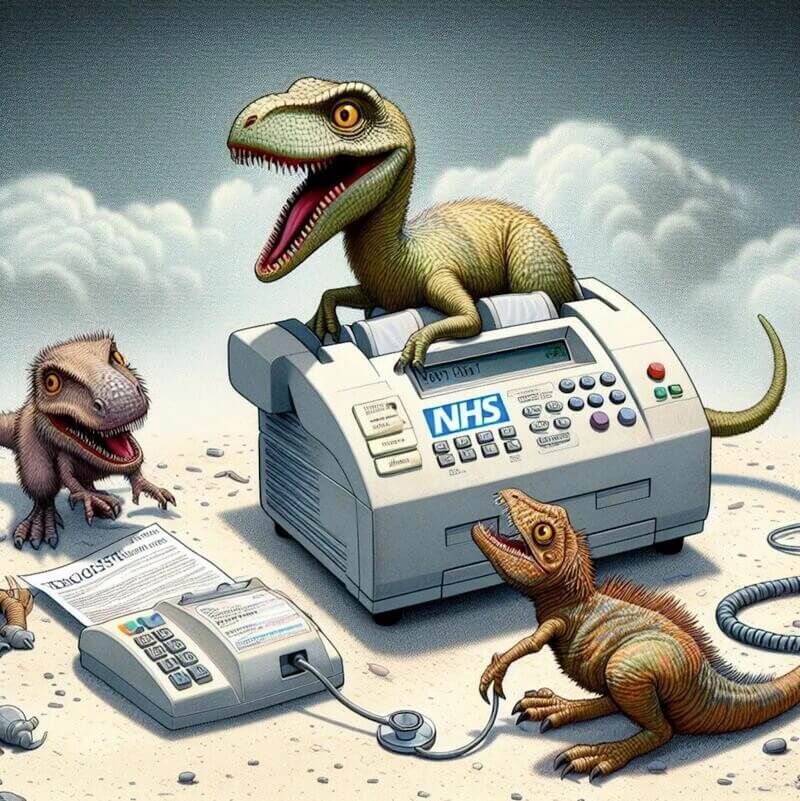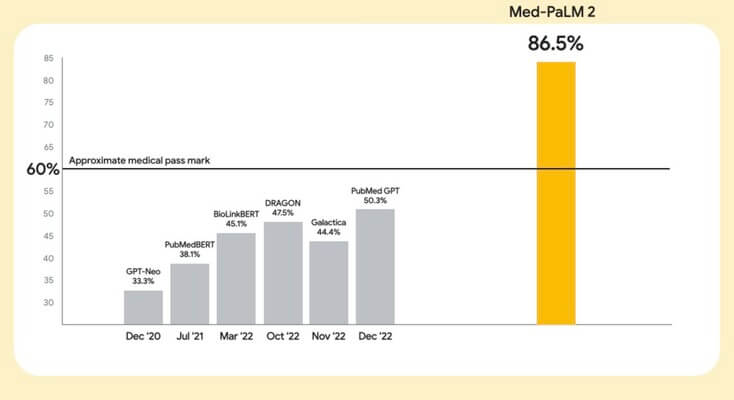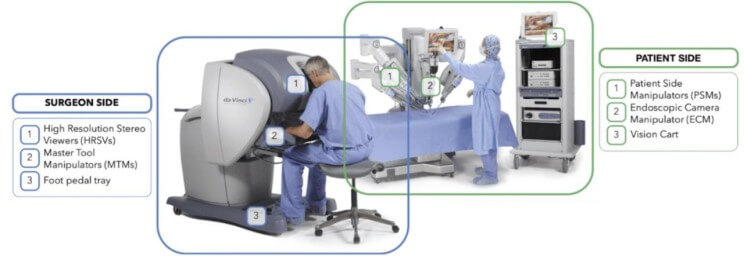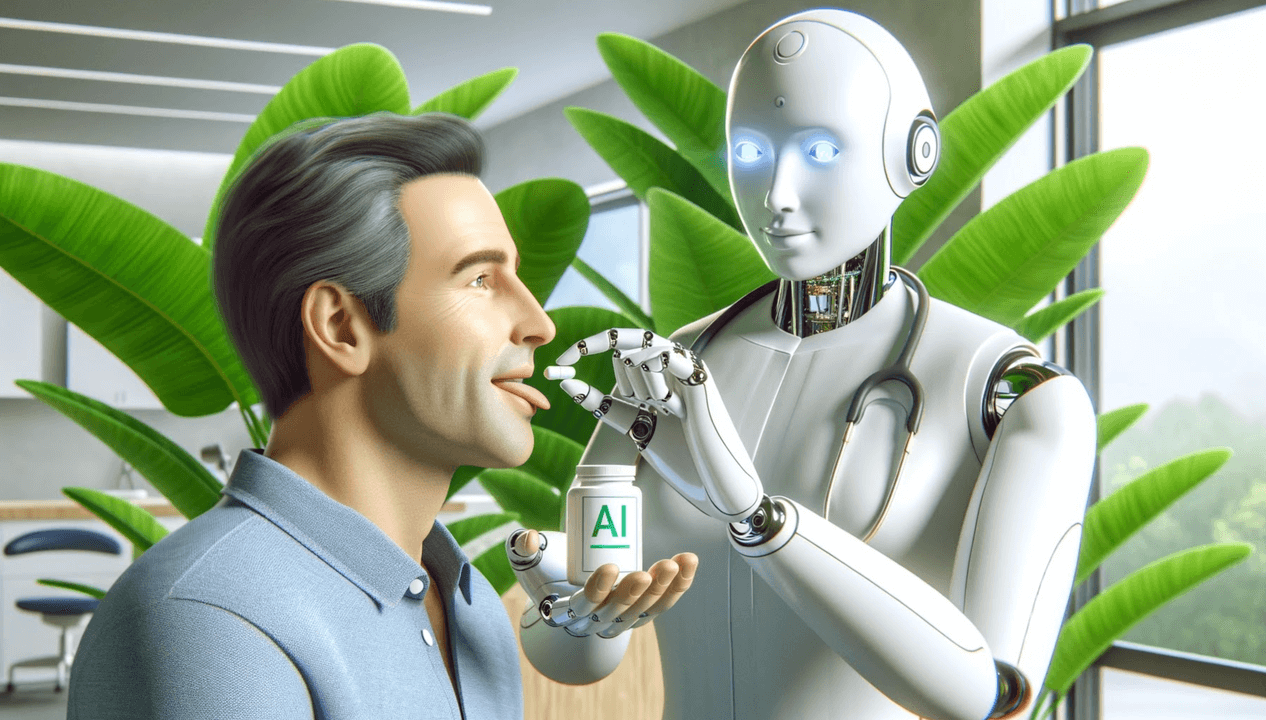In my 4th AI article, I begin a deeper dive into industry specific topics. Healthcare is arguably the prime example where AI is already making inroads, and could eventually revolutionise wellbeing, primary care, pharmacology, diagnostics and medical interventions.
Machine learning & AI – how did we get here?
In the early 1970s, researchers began to use Machine Learning (ML) for healthcare applications, with Initial work focussing on pattern recognition and classification.
The late 1990s brought us ML algorithms in diagnostic imaging, benefiting radiology by interpreting X-rays, MRIs, and CT scans, improving disease detection and bolstering diagnostic accuracy.
In the 2000s, healthcare pioneers focused on clinical decision support systems (CDSS) using ML creating insights for informed patient care decisions. Analysing extensive patient datasets, medical histories, and treatment outcomes, CDSS was able to offer enhanced personalised treatment recommendations.
The development of AlexNet, in 2012, a deep convolutional neural network, achieved unprecedented performance in image recognition tasks, showcasing the potential of deep learning.
The FDA granted approval in 2017, to IDx-DR, an AI-based diagnostic system for detecting diabetic retinopathy, marking the first FDA-approved autonomous AI diagnostic system.
In 2018, AI-driven drug discovery by companies like Insilico Medicine and Atomwise demonstrated potential to accelerate drug discovery timelines and improve success rates of new treatments.
AI demonstrated a major breakthrough in 2019, by performing as well as, or exceeding human experts in tasks such as detecting breast cancer from mammograms and diagnosing diseases from medical imaging scans.
COVID in 2020 highlighted AI’s role in pandemic response, including epidemiological modelling, drug discovery, and medical imaging analysis, effectively managing this most extreme healthcare crisis of modern times.
The status of healthcare today
Let’s start with the tough stuff. Great advances are never easy and AI in healthcare has many challenges to overcome.
Funding woes and bad actors – Since early 2023, healthcare AI startups have been struggling to access VC funding. Investors have tightened capital supply amidst too many inflated valuations. Although some areas such as value-based care, non-clinical workflow, and at-home care remained buoyant, general investment levels fell significantly.
High-profile collapses of fraud-ridden crypto exchange, FTX and blood doping, Theranos did not help matters and have supported a significantly more stringent approach to due diligence. These events exposed the dangers of inadequate process, prompting greater assurances and deeper insights, detailed financial audits, clinical provenance, corporate governance, and regulatory compliance.
Data Privacy and Security – The utilisation of AI in healthcare necessitates access to vast amounts of personal health information (PHI), raising significant concerns around data privacy and security. Ensuring the confidentiality, integrity, and availability of patient data while complying with regulations such as the UK GDPR and HIPAA (for US-based operations) is paramount.
Bias and Equity – AI systems are only as unbiased as the data they’re trained on. Historical health data can contain biases related to race, gender, socioeconomic status, and more. This can lead to AI models that perpetuate and even strengthen these biases, potentially leading to unequal healthcare outcomes. Addressing this requires careful curation of training datasets and rigorous testing methodologies.
Data Availability and Fragmentation – AI in healthcare hinges on access to vast, comprehensive datasets. Yet, health data is distributed across various systems in a very inconsistent fashion. This represents a major challenge to compile a complete data picture necessary for training robust AI models.

Integration with Existing Systems – Legacy systems exist in nearly all healthcare environments and are sometimes hopelessly outdated. I’m still reeling from learning fax machines are still being used, with a reason given as compliance to HIPAA privacy standards! Integrating AI solutions into these existing infrastructures without causing disruptions to workflows or requiring extensive retraining of staff is a significant challenge where we need to ‘build the plane as we fly it’.
Interpretability and Trust – Deep learning AI models can lack clarity on how its decisions are made. This can erode trust among healthcare providers and patients. Developing chain-of-thought, challengeable and transparent AI systems is crucial to gaining widespread acceptance.
Injuries and Error – AI systems might sometimes make incorrect decisions, leading to potential patient harm. This risk is particularly acute if an AI system’s error affects a large number of patients
Uncertainty Over Liability: With multiple stakeholders involved in the development, deployment, and usage of AI tools, determining liability when things go wrong remains complex. This uncertainty can hinder adoption and innovation.
Workforce Implications: Overall, the impact on employment in healthcare is nuanced, with automation – i.e replacement – of some roles, augmentation and the creation of new ones. Healthcare professionals must adapt, gain new expertise and integrate AI into clinical workflows.
Healthcare costs – Many nations are at breaking point and the infrastructure of care provision is struggling to maintain an efficient and effective service based on available budgets. The more affluent shore up their healthcare regime with private care subscriptions, while in the US around 530,000 people report medical bills to be a factor in their bankruptcy each year.
Our issues are compounded by an ageing population who require more intensive care in older life, more sophisticated interventions costing greater amounts to develop and administer and increasing populations globally.
Disruption and waiting times – The UK is suffering from record waiting times for appointments and operations while virtually all healthcare professionals have been on strike for periods of time in the last 2 years due to poor pay and working conditions.
But, can we fix healthcare with AI?
OK, now for the good stuff. AI could revolutionise the way healthcare is delivered globally. The benefits will be obvious and tangible but only if AI solutions are delivered with patient well being and ethics truly at the heart of all our efforts.
AI and surrounding technologies can alleviate much of the issues listed above – with caveats. Those who have skin in the healthcare game, excuse the medical pun, will fight to maintain and grow income and they hold many of the cards. For this to work we need the combination of commercial opportunity in the form of being able to treat greater numbers of people, with lower costs using novel interventions, aided by government support through AI focussed regulatory measures to ensure patients are properly protected.
Disruption using AI in healthcare is a potential opportunity. Startups and large tech companies have less legacy issues to get in the way of creating new market categories and challenging incumbent competitors. They also have little fear of stepping into adjacent or unrelated industry sectors.
Some of the great disruptors
Tesla – An innovative approach to electric vehicles has aggressively disrupted the traditional automotive industry, pushing major manufacturers to accelerate their own electric vehicle programs.
Amazon – With their purchase of Whole Foods and forays into healthcare and pharmacy services, Amazon have disrupted retail and healthcare industries, challenging established players.
Movie Streaming Services – The rise of the likes of Netflix and Disney+, has dramatically altered the entertainment landscape, leading to the decline of traditional TV viewing and changing how content is produced and consumed.
Zoom – The Impact on communication during COVID accelerated the adoption of remote work and communication technologies, with Zoom rapidly becoming a household name and disrupting traditional communication and conferencing industries.

Personalized Medicine via AI
Despite the incredible advances we have made in medicine in the last 100 years, we still have a huge way to go with many of life’s ailments, such as heart disease and cancer, still considered an inevitable fate. Medical interventions are developed with large cohorts in mind so treatments are a compromise to ensure they can be effective for as many people as possible.
AI and related technologies have the potential to challenge these most harmful conditions and literally make life better for all of us by creating medicines for a cohort of 1.
Being able to hone in on precise individual requirements may be one of the most effective medical interventions we could ever master – and it’s happening right now. Alongside this, the ability to understand the unique nature of every individual’s makeup may empower us to prevent a multitude of inherited and lifestyle-acquired illnesses ever occurring.
Let’s consider personalised medicine in 2 distinct areas:
Hyper personalised medicine
Where your life could be transformed or even depend on a drug, treatment or cure. Consider this a potential step change in the current best-of life saving medicines available.
Cancer Therapy: Customised chemotherapy and radiation based on genetic mutations in tumour cells.
Benefit: More precise and effective treatments with potentially fewer side effects.
Genetic Disorders: Specific gene therapies targeting the root causes of rare genetic conditions.
Benefit: Hope for cures or significant management improvements.
Autoimmune Diseases: personalised treatment plans based on individual immune system variations.
Benefit: Potentially reducing symptoms and halting disease progression more effectively.
Cardiovascular Diseases: Adapted medication regimens to match individual genetic predispositions related to heart conditions.
Benefit: Improving patient outcomes and reducing adverse reactions.
Mental Health: Personalised psychiatric medication based on genetic markers to improve efficacy and reduce side effects.
Benefit: Addressing mental health conditions more effectively
Vaccine Development: Creates vaccines tailored to individual immune system responses.
Benefit: Enhancing effectiveness and potentially reducing side effects.
Antibiotic Resistance: Focuses on developing antibiotics targeted at specific bacterial strains.
Benefit: Helping to combat the growing issue of antibiotic resistance.
Chronic Pain Management: Customises pain management strategies based on genetic markers related to pain perception and medication metabolism.
Benefit: Aiming for more effective pain relief.
A strategy for the ‘walking well’
AI is powering adaptations for everyone to benefit from to improve quality of life as well as longevity. Quality of life is now a mainstay in the quantitative factors considered important alongside the traditional one of longevity. We are all very familiar with fitness trackers that gather myriad data on us and then attempt to advise – but due to regulatory restrictions rarely diagnose – on how fit and well we are.

As good as these devices are, they are currently anecdotal with many outputs being no more than rough estimates, examples being, VO2 Max – a key metric denoting your aerobic capacity – and calories burned during any given exercise. AI is on track to support the development of more sophisticated hardware packed with better algorithms developed with higher quality data to take health and fitness to the next level.
Preventive Medicine: Uses genetic screening to identify early risk factors for diseases.
Benefit: Enabling early interventions and lifestyle changes to prevent disease onset.
Nutrigenomics: Custom nutrition plans based on genetic makeup.
Benefit: Enhance health and prevent disease.
Fitness Programs: Genetic data is utilised to customise fitness programs, analysing muscle composition to design exercises that maximise fitness outcomes.
Benefit: Workouts are scientifically tailored to individual genetic profiles, enhancing effectiveness and safety.
Personalised Supplements: Tailoring supplement regimens.
Benefit: Individual genetic needs for better health outcomes.
Sleep Optimization: Gathering of genetic data supported by individual sleep data metrics.
Benefit: Improved sleep quality and patterns for enhanced well-being.
Stress Management: Custom strategies based on genetic markers.
Benefit: Effective management and reduction of stress.
Allergy Management: Determining individual genetic susceptibility to allergies.
Benefit: Custom exposure plans and treatments.
Enhanced Ageing: Forming targeted interventions for individual longevity based genetic markers.
Benefit: Promote longevity, vitality and quality of life
Regulatory and Ethical Approval
Stringent regulatory standards like ISO 13485 for quality management and the US’s FDA‘s guidelines are critical to ensure patient safety and efficacy of care. Navigating these hurdles is complex, time consuming and very costly. Many companies never manage to overcome this and fail to gain the necessary approvals to market their products.
AI can streamline the FDA and ISO 13485 approval processes for companies by sophisticated QMS software, enhancing data analysis, ensuring compliance, and optimising documentation. Through predictive analytics, AI can identify potential compliance issues early, enabling corrective actions before they derail the project. Add to this, documentation automation and record maintenance required for regulatory approval and risk management. AI can increase the chances of achieving regulatory approval and reduce the associated Quality Management Systems (QMS) running costs as well as huge commercial gains made by reducing time to market.
Telehealth and Remote Monitoring
AI is set to revolutionise telehealth delivery way beyond current best-in-class services. Companies are already able to improve intervention outcomes via remote monitoring of individual health and using a number of remotely applied technologies. Allied with proprietary predictive analytics, AI can anticipate health events, enabling proactive management of chronic conditions. Healthcare providers also benefit from the capture of valuable streams of data from patient worn devices. This provides real-time data analysis and insights that can be acted on immediately in case of emergency care and collected as part of the patient’s healthcare regime.

In the future, we may be able to deliver telehealth through sophisticated agents manifesting as animated avatars of a medical practitioner, indistinguishable from a real person and able to hold full and abstract conversations with patients, whilst showing great levels of empathy.
With agents acting as virtual healthcare practitioners, this allows for huge scalability which in turn could significantly reduce service costs, optimising healthcare resources to where they are needed in person. It will also support patients to manage their health proactively, anytime and anywhere.
AI vs Doctors
Med PaLM 2, developed by Google, has achieved state-of-the-art results in medical competency, notably performing at expert level in US Medical Licensing Exam-style questions achieving over 85% accuracy. This marks a significant and rapid advancement and supports potential use cases for developing sophisticated agents to be used in primary care as a first point of contact for patients, subject to the necessary regulatory approvals.

Robotics in Surgery
AI in healthcare robotics is significantly advancing surgical practices. It enables precise surgery planning, real-time guidance during procedures, and detailed post-operative analysis. AI-driven systems can analyse vast data from patient records and imaging to tailor surgical strategies, predict outcomes, and identify risks. In surgery, AI is able to enhance the accuracy of robotic-assisted interventions, offering surgeons data-driven insights and operational support. This integration can lead to safer, more efficient surgeries with potentially better patient outcomes, marking a pivotal shift towards personalised and minimally invasive surgical care.

Pioneering the field of robotic surgery is the Da Vinci surgery robot. This well established technology exploits AI to aid in a variety of surgeries, including but not limited to, urological, gynaecological, colorectal, and general surgeries. It’s especially adept at performing minimally invasive procedures with enhanced precision, flexibility, and control beyond human capabilities, allowing for potentially shorter recovery times and reduced complications compared to traditional open surgery.
AI in Mental Health Services
Mental health is sharply in focus with rates of mental health treatments being completed at an all time high. As with other interventions, resources are scarce and expensive so AI augmentation in treatment is a welcome addition.
AI in mental health services can provide tools for early detection, personalised treatment, and continuous patient monitoring. Through analysing speech patterns, social media activity via sentiment analysis, and biometric data capturing facial expressions, AI algorithms can identify signs of mental health issues like depression and anxiety earlier.
Based on this rich data gathered, personalised therapy apps can deliver cognitive-behavioural therapy tailored to individual patient needs. Additionally, AI-driven chatbots can offer immediate, stigma-free support.
AGI
We can’t cover the future without mentioning Artificial General Intelligence (AGI) which is a very hot topic right now. If it is achieved in the short term – i.e. in the next 2 years – it will only accelerate healthcare innovation more quickly, due to AGI being able to create solutions with minimal support required outside of the original scope supplied, allied with advances in creating high quality synthetic data and digital twins.
Synthetic data
Synthetic data in healthcare when combined with AI systems capable of safe and accurate unsupervised learning would have an enormous impact. Synthetic data in the healthcare context would consist of artificial patient and environmental data mirroring real-world complexities, enabling researchers to conduct extensive studies without risking personal privacy or patient health. Unsupervised capabilities here will help to accelerate drug development, improve predictive models for disease progression, and enhance personalised medicine strategies, ultimately leading to more effective and safer healthcare solutions.
Digital twins
Digital twins in medical development promise to revolutionise personalised healthcare by creating highly accurate, individualised patient models. These virtual replicas simulate the complex physiological and genetic makeup of patients, enabling researchers and clinicians to predict disease progression, optimise treatment plans, and conduct virtual trials of new drugs or therapies. The advantages over traditional research are greater safety, lower costs and gathering of rich datasets that can be used to continuously refine models and create new ones. Although digital twins are used comprehensively today, their full potential would be fully realised when combined with on-demand, high quality synthetic data.
Future AI blockbusters
Given the sci-fi-esque breakthroughs being hypothesised online, it makes sense to indulge in some blue sky thinking on AI concepts that just a year or so ago would have been scoffed at. Given the unprecedented pace of AI in the last year, many of these now feel within touching distance.
AI-Powered Nanobots for Surgery: Tiny robots, controlled by AI, navigate the body to perform precise surgeries without incisions.
AI-Enhanced Genetic Editing: CRISPR-Cas9 is making genetic editing more routine. Ultimately this could allow for correction of virtually any genetic defect, the eradication of inherited diseases, the customization of genetic traits, and the enhancement of human capabilities.
Brain-Computer Interfaces: AI deciphers neural patterns, enabling direct brain-to-device communication, restoring mobility in paralysis, restoring communication for locked-in syndrome, neurological disorder treatment for conditions like epilepsy and Parkinson’s and cognitive enhancement.

Organ Printing: 3D printed personalised organs for transplantation to be commonplace, reducing wait times and rejection rates.
Smart Prosthetics: Next generation AI-powered prosthetics with sophisticated sensory feedback adapting to users’ movements, closely mimicking natural limb function.
Virtual Pharmacies: AI designs personalised medication regimens, synthesised on-demand at home.
AI-Driven Health Ecosystems: Integrated platforms where AI monitors public health data to predict and manage outbreaks.
Quantum Computing in Drug Discovery: Using quantum computing to simulate molecular interactions, speeding up drug discovery, making personalised drug therapies possible and vaslty reducing associated costs.
Conclusions
The healthcare environment is primed for the best and most impactful aspects of AI in existing cutting edge and future medical technologies that will likely change all our lives.
I strongly believe the exponential rate of progress in AI is going to continue for some time yet. As I wrote in a previous article, the convergence of tech will supercharge a vast array of new solutions to improve patient outcomes from analysing patient records to performing automated surgeries.
Back to reality, it’s clear that none of this can happen without a major upheaval of the healthcare industry and major issues will occur without vital checks and balances in place. Corporate entities must balance ambition with ethics and bias front and centre of any strategy.
I’m most excited by the leverage that AI will have over pushing the physical workforce to where it’s required most. Fully AI and AI augmented processes will be able to so much of the heavy lifting of admin and in the future, interventions that we have not yet even thought of.
The healthcare job market will see significant upheaval as well in the short to medium term, but should create more winners than losers for workers and the patients they care for. As with other industry sectors, we must not fight the inevitable, but get on board and make it work for us.
If you have found this useful and would like to know how I might help your company, please reach out to me.

